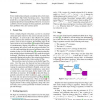Free Online Productivity Tools
i2Speak
i2Symbol
i2OCR
iTex2Img
iWeb2Print
iWeb2Shot
i2Type
iPdf2Split
iPdf2Merge
i2Bopomofo
i2Arabic
i2Style
i2Image
i2PDF
iLatex2Rtf
Sci2ools
CCCG
2006
2006
Polygons Flip Finitely: Flaws and a Fix
Every simple planar polygon can undergo only a finite number of pocket flips before becoming convex. Since Erdos posed this as an open problem in 1935, several independent purported proofs have been published. However, we uncover a plethora of errors and gaps in these arguments, and remedy these problems with a new (correct) proof. 1 Pocket Flips Given a simple polygon in the plane, a pocket is a maximal connected region interior to the convex hull and exterior to the polygon. A (pocket) flip is the reflection of a pocket, or more precisely the subchain of the polygon bounding the pocket, across its line of support, the bounding edge of the convex hull. In 1935, Paul Erdos [3] introduced the problem of simultaneously flipping all pockets of a simple polygon, and repeating this process until the polygon becomes convex. He conjectured that this process terminates after a finite number of steps. In 1939, B
CCCG 2006 | CCCG 2007 | Finite Number | Pocket | Polygon |
| Added | 30 Oct 2010 |
| Updated | 30 Oct 2010 |
| Type | Conference |
| Year | 2006 |
| Where | CCCG |
| Authors | Erik D. Demaine, Blaise Gassend, Joseph O'Rourke, Godfried T. Toussaint |
Comments (0)

